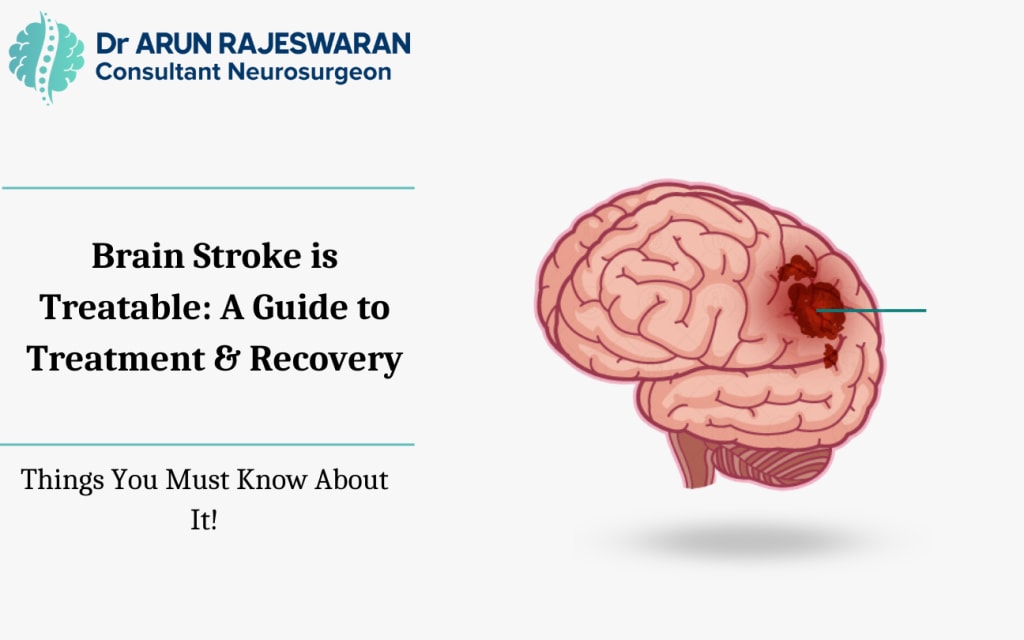Brain Stroke is Treatable: A Guide to Treatment & Recovery
Best Neurosurgeon In Abu Dhabi

I. Introduction to Brain Stroke
A brain stroke, also known as a cerebrovascular accident, occurs when the blood supply to a part of the brain is disrupted, leading to the death of brain cells. Strokes can be categorized into two main types: ischemic and hemorrhagic. Ischemic strokes are caused by a blockage or clot in a blood vessel supplying the brain, while hemorrhagic strokes result from bleeding in the brain due to a ruptured blood vessel.
Strokes are a major health concern globally, with around 15 million people worldwide experiencing a stroke each year. The risk factors for stroke include high blood pressure, smoking, diabetes, high cholesterol, and a family history of stroke. The warning signs of stroke include sudden weakness or numbness in the face, arm, or leg, difficulty speaking or understanding speech, sudden blurred or loss of vision, sudden severe headache, and dizziness or loss of balance.
Immediate medical intervention is crucial in stroke management. The faster the treatment is given, the better the chances of a positive outcome for the patient.
Read this: Best Neurosurgeon in Abu Dhabi
II. Understanding Stroke Treatment
Emergency medical response is critical for suspected stroke cases. The patient will undergo an initial assessment to determine the type of stroke and the severity of the symptoms. Treatment options for ischemic stroke include thrombolytic therapy, which involves the administration of medication to dissolve the clot and restore blood flow to the affected area. Endovascular procedures, such as thrombectomy, involve the removal of the clot through a catheter inserted into the blood vessels.
Surgical interventions may be necessary for hemorrhagic strokes. A decompressive craniectomy, which involves the removal of part of the skull to relieve pressure on the brain, may be performed in severe cases of bleeding in the brain.
Specialized stroke centers and experienced healthcare professionals are essential in stroke treatment. The availability of these resources can significantly improve patient outcomes.
III. Rehabilitation and Recovery
Post-acute care and rehabilitation are critical for stroke survivors. The multidisciplinary approach to stroke recovery involves physical therapy to improve mobility, occupational therapy to relearn daily activities, speech therapy to regain speech and language skills, and cognitive rehabilitation to address any cognitive challenges.
Stroke-related impairments, such as mobility issues, speech and language difficulties, and cognitive challenges, can be managed with appropriate strategies. Support from caregivers, family, and community is also essential in stroke recovery.
IV. Managing Stroke Risk Factors
Lifestyle modifications, such as adopting a balanced diet, engaging in estregular exercise, and quitting smoking, can help prevent recurrent strokes. Medications for managing stroke risk factors, such as antihypertensives, anticoagulants, and lipid-lowering agents, may also be prescribed. Regular medical check-ups to Neurosurgeon.
Education on stroke risk factors and prevention strategies is also critical for stroke survivors and their caregivers.
V. Psychological Impact of Stroke
Stroke can have a significant emotional and psychological impact on survivors and their families. Post-stroke emotional challenges, such as depression, anxiety, and mood swings, can be managed with appropriate strategies. Mental health support and counseling are essential in stroke recovery.
VI. Lifestyle Modifications for Stroke Recovery
Adopting healthy lifestyle changes, such as eating a balanced diet, engaging in regular exercise, getting adequate sleep, and managing stress, can promote overall well-being and aid in stroke recovery. Strategies for managing post-stroke challenges, such as fatigue, cognitive changes, and lifestyle adjustments, should also be implemented.
Frequently Asked Questions (FAQs) About Brain Stroke
Q1:Is brain stroke treatable?
Yes, brain stroke is treatable. Timely medical intervention is crucial in managing strokes effectively. The treatment options depend on the type of stroke, whether it is ischemic or hemorrhagic. Ischemic strokes can be treated with thrombolytic therapy or endovascular procedures to remove the blood clot and restore blood flow to the brain. Hemorrhagic strokes may require surgical interventions, such as decompressive craniectomy, to lieve pressure on the brain caused by bleeding.
Q2: What are the treatment options for ischemic and hemorrhagic strokes?
Ans::For ischemic strokes, thrombolytic therapy and endovascular procedures, such as mechanical thrombectomy, are commonly used treatment options. Thrombolytic therapy involves the administration of medication to dissolve the blood clot and restore blood flow to the brain. Endovascular procedures involve the use of specialized tools to physically remove the clot from the blood vessels.
For hemorrhagic strokes, treatment options may include surgical interventions, such as decompressive craniectomy, to relieve pressure on the brain caused by bleeding. In some cases, medication may also be used to control blood pressure and manage other symptoms.
Q3: What is the role of rehabilitation in stroke recovery?
Ans: Rehabilitation plays a critical role in stroke recovery. After the acute phase of stroke treatment, rehabilitation focuses on helping stroke survivors regain their functional independence and improve their quality of life. Multidisciplinary rehabilitation programs may include physical therapy to improve mobility and strength, occupational therapy to regain daily living skills, speech therapy to address speech and language difficulties, and cognitive rehabilitation to improve cognitive function.
Rehabilitation also involves addressing emotional and psychological challenges that stroke survivors may face, such as depression, anxiety, and mood swings. Rehabilitation programs are tailored to the individual needs of stroke survivors and are an essential part of the recovery process.
Q4:How can stroke risk factors be managed to prevent recurrent strokes?
Managing stroke risk factors is crucial in preventing recurrent strokes. Lifestyle modifications can play a significant role in reducing the risk of stroke. This includes adopting a healthy diet that is low in sodium, saturated fats, and cholesterol, regular exercise, maintaining a healthy weight, managing stress, and avoiding smoking and excessive alcohol consumption.
In addition to lifestyle changes, medication may also be prescribed to manage stroke risk factors, such as antihypertensives to control high blood pressure, anticoagulants to prevent blood clots, and lipid-lowering agents to manage high cholesterol levels. Regular medical check-ups and adherence to prescribed medications are essential in managing stroke risk factors and preventing recurrent strokes.
Conclusion:
In conclusion, the article has discussed various key points related to stroke treatment and recovery. Timely medical intervention, including thrombolytic therapy, endovascular procedures, and surgical interventions, are crucial in treating strokes effectively. Rehabilitation plays a vital role in helping stroke survivors regain their functional independence and addressing emotional and psychological challenges. Lifestyle modifications, such as adopting a healthy diet, regular exercise, and managing risk factors, are important in preventing recurrent strokes. The emotional and psychological impacts of stroke on survivors and their families are significant and may require additional support. The article emphasizes the importance of seeking appropriate medical care, engaging in rehabilitation, and making lifestyle modifications for optimal outcomes in stroke treatment and recovery.
About the Creator
Enjoyed the story? Support the Creator.
Subscribe for free to receive all their stories in your feed. You could also pledge your support or give them a one-off tip, letting them know you appreciate their work.






Comments
There are no comments for this story
Be the first to respond and start the conversation.